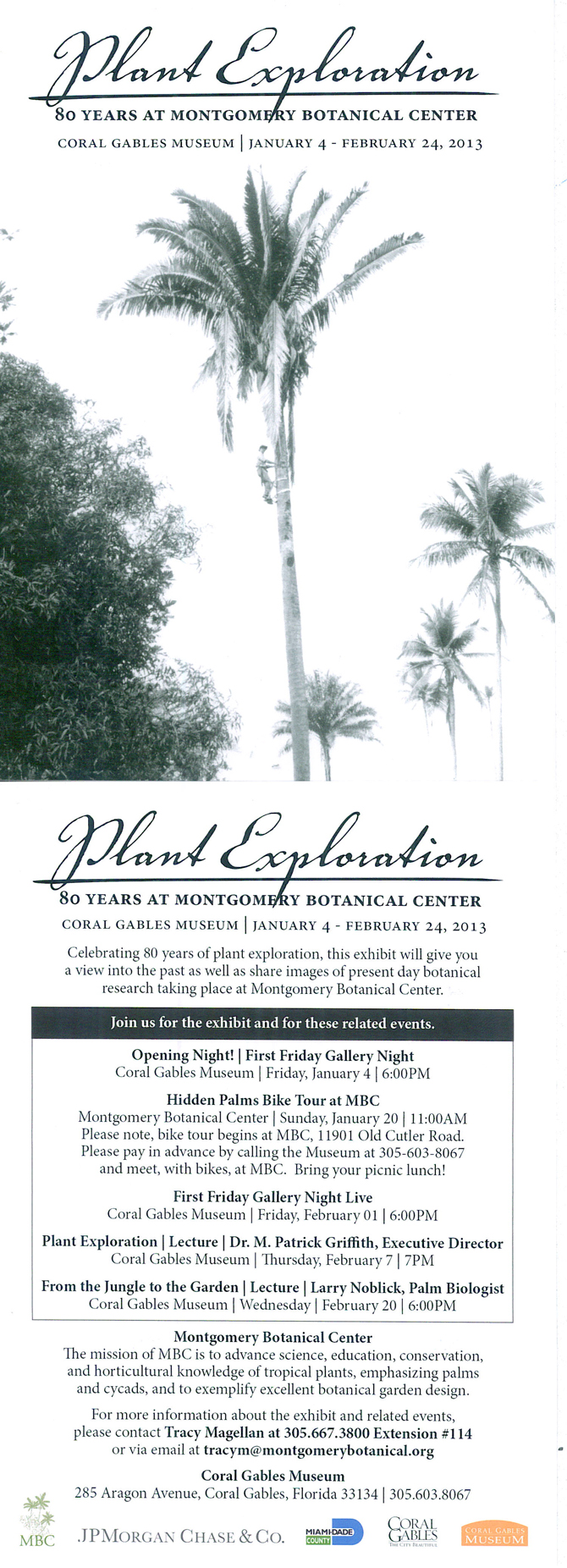December 19, 2013
Lecture: Hungary and the Hungarian Natural History Museum
Speaker: Dr. Boglarka Erdei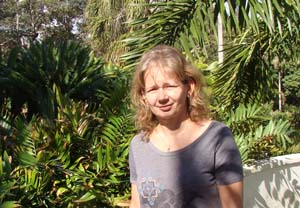
Time and date: Thursday, December 19. Reception: 2:00 PM, presentation, 2:30 PM
Location: Montgomery Botanical Center, Nixon Smiley Meeting Room
About the Speaker: Dr. Erdei is Chief Museologist at the Hungarian Natural History Museum, and Research Fellow at Montgomery Botanical Center. Her yearlong fellowship at MBC is funded by the Hungarian American Enterprise Scholarship Fund (HAESF). Dr. Erdei is an expert on fossil cycads, and is working to compare these fossils to our living cycad collection.
About the Presentation: As part of her Fellowship, MBC and HAESF are excited to have Dr. Erdei offer an informal presentation about Hungary. She writes:
“I would like to invite you to an unconventional presentation, to have a taste of culture including some Hungarian cookies, coffee and other snacks. With this short (approx. half hour) presentation I would like to introduce my country and my home institution in a nutshell. I hope we can have a pleasant time together and share some Christmas cheer.”
December 12, 2013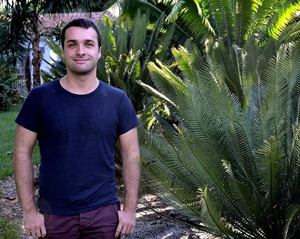
Lecture: Electron Microscope Studies in Dioon
Speaker: James Clugston, Royal Botanic Garden Edinburgh, Scotland, UK. Date & time: Thursday, December 12, at 2:00 PM. (Reception with refreshments at 2:00 PM, talk from 2:30-3:15 PM.)
Location: Nixon Smiley Meeting Room, Montgomery Botanical Center, 11901 Old Cutler Road, Coral Gables, FL 33156
About the presentation: Dioon is the most basal genus in the cycad family Zamiaceae. During this talk James will share his findings on how Dioon leaflet cuticular micromorphology relates to taxonomy and to climate differences between Florida and Mexico. This research was carried out at Montgomery Botanical Center and the Institute for Ecology in Xalapa, Mexico.
Brought to you with the support of the City of Coral Gables and the Kelly Foundation.
November 2013
Fall/Winter 2013 Montgomery Botanical News is Now Online!
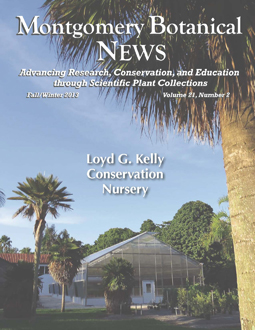 This new issue highlights Loyd Kelly's contributions to Montgomery. This spring we dedicated the Loyd G. Kelly Conservation Nursery, a facility that promotes better plant health and allows for improved plant conservation and plant diversity. Loyd Kelly attended the dedication before he passed away on June 27, 2013. Please see pages 3, 4, and 8 for more information on Loyd Kelly and his impact on MBC.
This new issue highlights Loyd Kelly's contributions to Montgomery. This spring we dedicated the Loyd G. Kelly Conservation Nursery, a facility that promotes better plant health and allows for improved plant conservation and plant diversity. Loyd Kelly attended the dedication before he passed away on June 27, 2013. Please see pages 3, 4, and 8 for more information on Loyd Kelly and his impact on MBC.
Montgomery is also pleased to announce Walter Haynes's generous endowment of the Landscape Design Fund. Landscape design and garden aesthetics have always been a critical component of the MBC mission. This fund will ensure that Montgomery will always have the means to support professional landscape architecture design for the garden.
This year Montgomery Botanical Center has been recognized at local, national, and international levels (please see page 7). A few new publications are highlighted, but more can be found on our online bibliography. Also, on page 7 you will find an announcement of the launch of the World List of Cycads, a new online database of cycad species.
Montgomery Botanical Center publishes two newsletters a year to keep our supporters and collaborators up to date and informed.
To read more about how Montgomery Botanical Center meets our mission of "Advancing Research, Conservation, and Education through Scientific Plant Collections" please see our newsletters online.
November 11, 2013
Association Fous de Palmiers Explores the Palm Collections of MBC
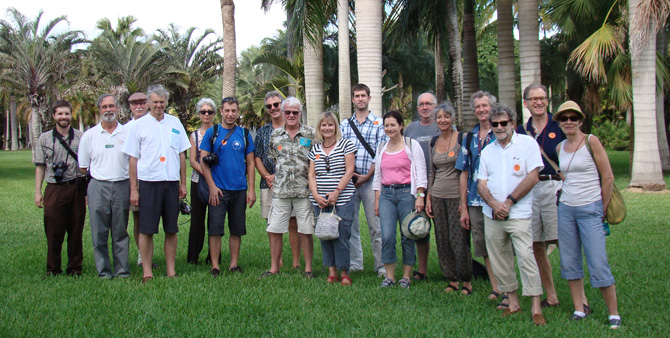
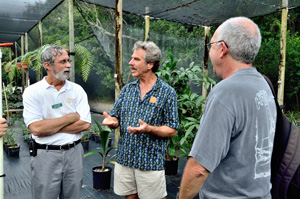 On Monday November 11, a French palm society, Association Fous de Palmiers, visited MBC to explore our palm collections. Members of the society in attendance were from various parts of France, Switzerland, Guadeloupe and French Guiana. The society had first visited MBC about eight years ago and was eager to re-visit the rapidly expanding collection. The tour was lead by MBC Palm Biologist Dr. Larry Noblick, with assistance from Tracy Magellan and Dr. Chad Husby.
On Monday November 11, a French palm society, Association Fous de Palmiers, visited MBC to explore our palm collections. Members of the society in attendance were from various parts of France, Switzerland, Guadeloupe and French Guiana. The society had first visited MBC about eight years ago and was eager to re-visit the rapidly expanding collection. The tour was lead by MBC Palm Biologist Dr. Larry Noblick, with assistance from Tracy Magellan and Dr. Chad Husby.
The tour covered a large portion of the palm collection, including highlights such as the critically endangered Haitian palm Attalea crassispatha, the unique mangrove palm Nypa fruticans, the giant Corypha taliera, Syagrus vermicularis, a species first described by Larry, and finishing with a specimen of the true Butia capitata, a species which Larry re-circumscribed. Chad led the group on a tour of the nursery afterwards.
After MBC, the Association Fous de Palmiers will be be exploring other palm collections and natural habitats in South Florida and will return home next week.
November 7, 2013
Public Garden Management Class Visits Montgomery
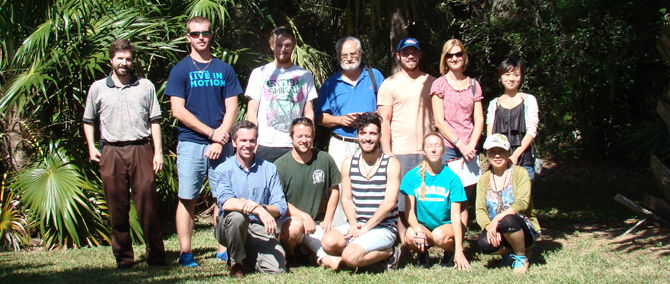
Nine horticulture students and Professor Emeritus Bijan Dehgan from UF travelled a great distance from Gainesville to visit the gardens of South Florida this week. The students are studying Public Garden Management, as part of their undergraduate curriculum. After visiting Mounts Botanical Garden the prior day, their first stop in Miami-Dade County was Montgomery, before continuing on to Fairchild, Vizcaya, and The Kampong over two days.
The students spent time with Patrick Griffith, Tracy Magellan, and Chad Husby, learning about MBC’s research and conservation efforts. Dr. Dehgan writes, “Having visited Montgomery with the students in the past I feel as the only research garden it is most appropriate for the student’s field trip.”
Chad states, “Montgomery provided a unique example to the students of how a public garden can be managed to maximize the conservation and scientific value of its living plant collections.”
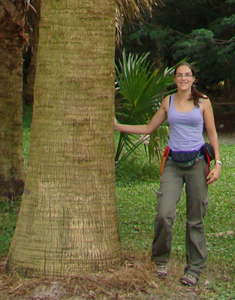 November 5, 2013
November 5, 2013
Angela Cano, Palm Expert from Geneva
Angela Cano has returned to Montgomery to continue her studies of palm diversity and evolution. She was last here in 2010 while completing her Masters Degree from the Conservatoire et Jardin botaniques de la Ville de Genève, in Switzerland. Previously at Montgomery, she collected specimens of Trithrinax, and her research on that palm genus was recently published and featured on the cover of Phytotaxa.
Angela spent a week at Montgomery collecting palms, and also visiting the FTG Herbarium and collecting at Fairchild. Angela states: “I had a wonderful time in Montgomery and I was able to collect everything I wanted to. The collection is very impressive and the way it is curated and organized is impeccable. It is a real pleasure to work in Montgomery.” Angela next continues her travels to Panama, where she will perform further fieldwork.
The Conservatory and Botanic Garden of Geneva has perhaps the longest tradition of systematic botany among botanic gardens, and is also a center in palm research; MBC Research Fellow Dr. Fred Stauffer is also based there, and Dr. Stauffer is Angela’s major professor. The Conservatory and Botanic Garden of Geneva will also host the 6th Global Botanic Garden Congress (see immediately below) in 2017.
October 25, 2013
Montgomery at the World Botanic Gardens Gathering
Patrick Griffith, MBC Executive Director travelled to Dunedin, New Zealand, as a delegate to the 5th Global Botanic Garden Congress. Convened by Botanic Gardens Conservation International and hosted by Dunedin Botanic Garden, the meeting brought together over 300 experts from over 40 nations to discuss the present and future of botanic gardens.
Patrick presented two research projects at the Congress. First was a presentation on the conservation genetics of cycads, based on work funded by the IMLS. Additionally, Patrick presented a poster on the Caribbean Cycad Project, the large collaborative effort led by USDA, FTBG, NYBG, and MBC (click here for larger size). Patrick’s travel to the conference was partially supported by National Science Foundation through the grant in support of Caribbean Zamia research.
Patrick states: “I was happy to present our work, but far and away the main benefit of this great conference is having a chance to learn about what is new in the field, make new connections and strengthen old ones. I was thrilled to see so many great projects happening around the world.”
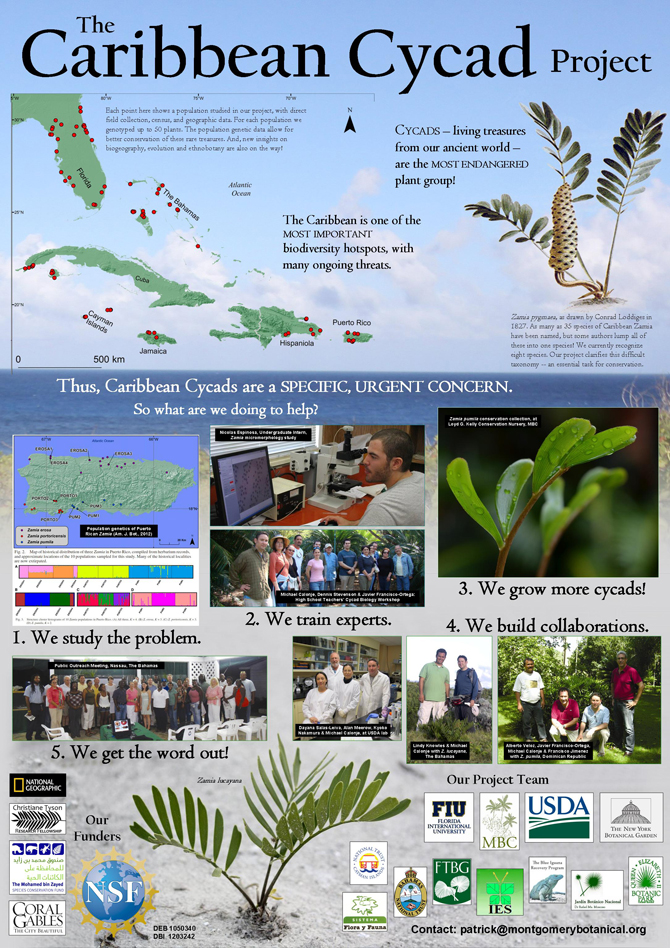
October 17, 2013
Return to the Dominican Republic: Palms, Conifers, Cycads and More
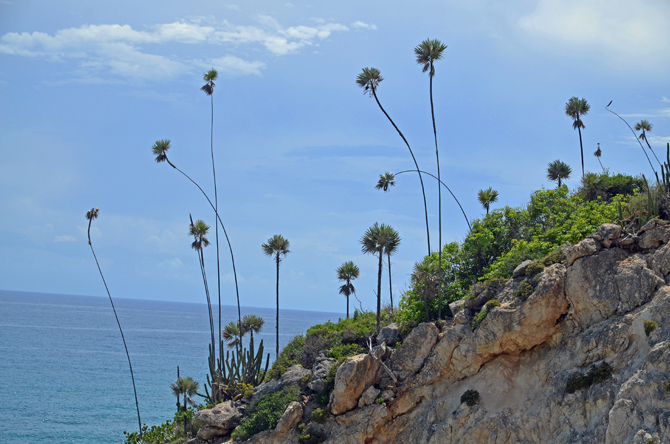
Building on long and fruitful collaborations, MBC once again teamed up with the Jardín Botánico Nacional Dr. Rafael Ma. Moscoso of the Dominican Republic (JBSD) and Fairchild Tropical Botanic Garden (FTBG) to collect a wide diversity of plants in the Dominican Republic for scientific, conservation and ornamental purposes from October 7-17. The expedition was supported by a generous donation of Dr. Lin Lougheed, who also supported the previous expedition in 2012.
The flora of the island of Hispaniola, of which the Dominican Republic comprises two thirds, is very rich and encompasses over 2,000 endemic species. Like South Florida it is part of the Caribbean bio-region, so many Dominican plants will thrive under our conditions.
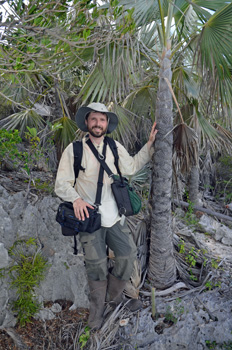 The expedition team was encouraged to return to the Dominican Republic by Ricardo Garcia, Director General of JBSD. The collecting team consisted of Dr. Chad Husby (Collections Manager and Botanist) of MBC and Jason Lopez (Living Collection Manager) of FTBG who focused on collecting living material, Dr. Brett Jestrow (Herbarium Curator) of FTBG who collected locality data and voucher specimens, Expert botanist Teodoro Clase of JBSD who guided most of the expedition and Alberto Veloz (Herbarium curator) who guided the team to a special palm population. Francisco Jiménez Rodríguez (Botanical Department Director) of JBSD coordinated the visit.
The expedition team was encouraged to return to the Dominican Republic by Ricardo Garcia, Director General of JBSD. The collecting team consisted of Dr. Chad Husby (Collections Manager and Botanist) of MBC and Jason Lopez (Living Collection Manager) of FTBG who focused on collecting living material, Dr. Brett Jestrow (Herbarium Curator) of FTBG who collected locality data and voucher specimens, Expert botanist Teodoro Clase of JBSD who guided most of the expedition and Alberto Veloz (Herbarium curator) who guided the team to a special palm population. Francisco Jiménez Rodríguez (Botanical Department Director) of JBSD coordinated the visit.
This expedition introduced a new and beautiful palm to MBC's living collections, Coccothrinax boschiana which grows in a small area where the Sierra Martin Garcia descends into the Caribbean. It is a beautiful species with gold and silver hued leaves and tall flexible stems, which allow it to withstand powerful cyclones that periodically strike the Dominican Republic. Thriving in a hot dry (yet humid) climate on treacherous dogtooth limestone, C. boschiana will be well adapted to thrive at MBC during all seasons.
In addition, the expedition team collected the first documented wild-origin seed of the emblematic Zombia antillarum to be grown in South Florida botanic gardens. Two stately specimens of this very hardy and spiny palm, which were planted in Col. Montgomery's time, flank the front door to Nell's House.
The team collected more seeds of the massive Sabal domingensis, which was first introduced to South Florida cultivation by the 2012 expedition to the Dominican Republic. Seeds of Copernicia berteroana were another important palm acquisition. The team also collected seeds of the endemic Dominican cycad, Zamia pumila, from a remote population not currently represented in MBC's collection.
Of the nearly 100 species collected by the expedition team for their respective gardens, other highlights included the endangered conifer Podocarpus hispaniolensis, which has not been cultivated before. The giant Plumeria, P. magna, is another exciting new introduction to cultivation in South Florida, along with more seedlings of the iconic palm-like Clavija domingensis, which is a major ex-situ propagation success of the JBSD. A new record of a primeval lycopod variety for the Dominican Republic was an important discovery by the expedition team.
Plants collected by the team will provide important scientific and conservation collections for all three institutions. Collecting living material and herbarium vouchers of so many important plants in so little time required each institution to share the expertise and efforts of its staff to the great benefit of all. We look forward to further fruitful collaborations to explore the rich and wonderful flora of the Dominican Republic.
October 10, 2013
Ancient Plants Meet Modern Microscopes
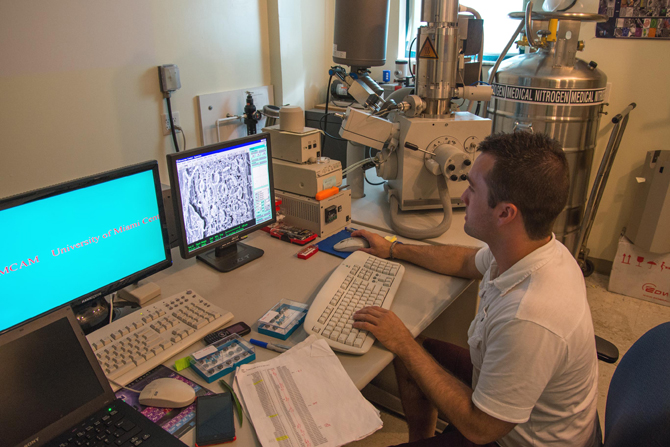
An exciting study underway at Montgomery! James Clugston, Kelly Botanical Research Fellow, and recent MSc Biodiversity and Taxonomy of Plants Graduate from the Royal Botanic Gardens Edinburgh, is here to examine cycad leaf surfaces using advanced techniques.
James, pictured here at the University of Miami Center for Advanced Microscopy, is working with the Montgomery plant collections to survey the diversity in cycad leaf surfaces, and determine if the leaf cuticles of Dioon can be used for identification. This builds upon James’ recent similar work with Podocarpus for his Masters Thesis. James states: “I believe that leaf cuticles are an important character in cycads that could ultimately help as a tool to delimitate species.”
Furthermore, the study is being performed in collaboration with Dr. Andrew Vovides of the Jardin Botanico Francisco Clavijero (Xalapa Mexico), a longtime collaborator of MBC. James will travel to Dr. Vovides’s lab later this fall to share his results.
James’s work at Montgomery is generously supported by the Kelly Botanical Research Fellows Program, which is generously funded by the Kelly Foundation.
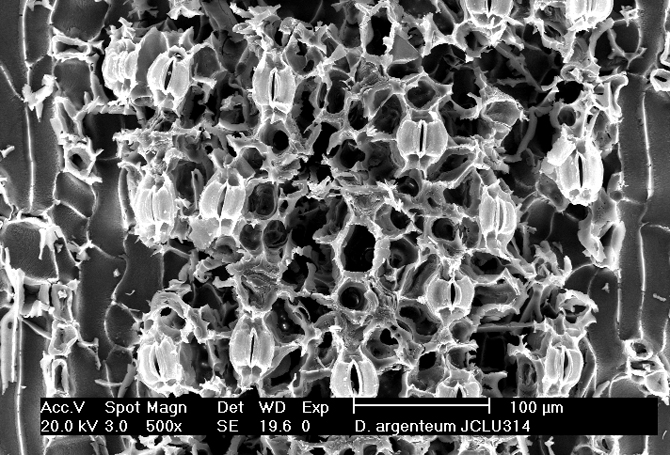
October 2, 2013
New Findings at Montgomery Help Conserve Cycads
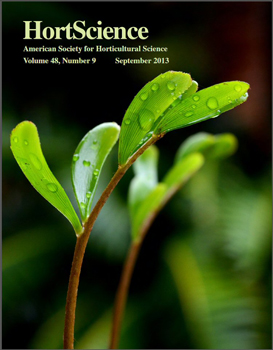 Protective cultivation is essential for many cycad species. But what are the safest and best methods for growing robust cycad seedlings? A new project led by Vickie Murphy, MBC Nursery Curator, sought to maximize survival and growth of young cycads.
Protective cultivation is essential for many cycad species. But what are the safest and best methods for growing robust cycad seedlings? A new project led by Vickie Murphy, MBC Nursery Curator, sought to maximize survival and growth of young cycads.
Although many soils are used by nurseries, the rarity and value of cycads prohibits many growers from experimentation with these treasured seedlings. A recent surplus of garden-cultivated Zamia pumila seed, provided by colleagues at Jardín Botánico Nacional Dr. Rafael Ma. Moscoso, allowed for rigorous scientific evaluation of media effects on cycads.
The experiment evaluated nine different media types with rigorous controls and statistics, from traditional organic mixes to more technical media such as fired clay. The results suggest that silica sand promotes the most robust growth and health of Zamia seedlings, and careful statistical evaluation suggests the air space provided by this medium was helpful.
Vickie performed this study as part of her Masters Thesis in Horticulture at the University of Florida. In addition to Vickie’s new academic findings, the science is directly relevant to Montgomery’s work. Vickie highlights how the efficiency gains help:
Greenhouse space is much like real estate: every square foot counts! Increasing the growth rate of cycads in the nursery reduces the number of years it takes to get them planted out in the garden. This opens up more space to conserve new plants.
The research is featured on the cover of the latest issue of HortScience, published by the American Society for Horticultural Science.
October 2013
New Paper on Palm Leaf Anatomy
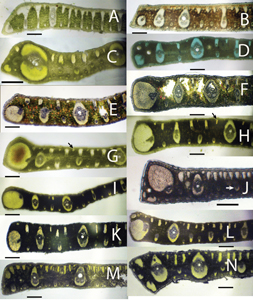 A new paper to report: Larry Noblick has published an extensive study of leaflet anatomy for the genus Syagrus. Larry’s recent work focused on the group of “stemless palms,” like the S. graminifolia from Brazil pictured here, which are very hard to tell apart using conventional morphology. Quoting from the paper:
A new paper to report: Larry Noblick has published an extensive study of leaflet anatomy for the genus Syagrus. Larry’s recent work focused on the group of “stemless palms,” like the S. graminifolia from Brazil pictured here, which are very hard to tell apart using conventional morphology. Quoting from the paper:
In fact, about 25 out the 54 currently recognized species of Syagrus are acaulescent or short stemmed and their identification remains challenging with many having formerly been dismissed as Syagrus petraea. Palms that do not have visible above ground stems are often referred to as acaulescent meaning “without a stem.” In fact all palms have a stem.
The new study, which appears in the latest PhytoKeys, coincides with and verifies many of the findings in Meerow et al.’s 2009 phylogeny of Syagrus. Additionally, the anatomical variation is presented as a dichotomous key, which offers a way to distinguish these little-known, difficult to indentify palms. Larry concludes:
As a disclaimer, I feel that this key is still not the final word and will need further revision as new species are discovered and others get reworked. The same species grown under different growing conditions or adult and juvenile forms may look slightly different, but the anatomy maybe an important tool in helping us to resolve these issues. I suspect that some species which appear to be morphologically different but anatomically similar may turn out to be the same species.
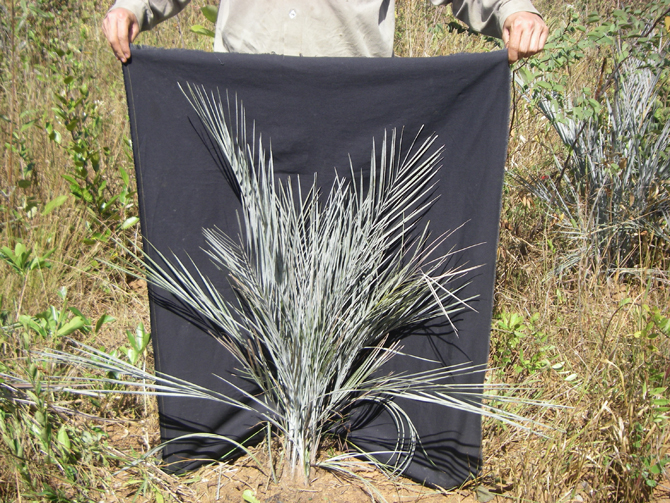
September 2013
New Research on Cycad Phylogeny
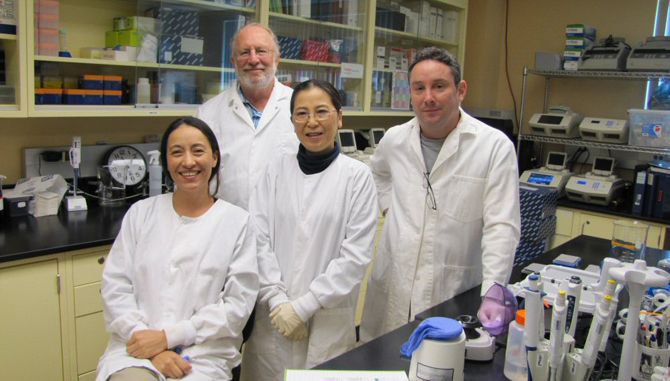
An exciting new finding on cycads! A new paper in the journal Annals of Botany resolves long-standing questions on how extant cycads are related.
 The study, led by Dayana Salas-Leiva, postdoctoral researcher at FIU, and Alan Meerow of the USDA (pictured here at Chapman Field with Kyoko Nakamura and MBC’s Michael Calonje), used new techniques to determine the positions of Dioon, Bowenia and Stangeria relative to other cycads.
The study, led by Dayana Salas-Leiva, postdoctoral researcher at FIU, and Alan Meerow of the USDA (pictured here at Chapman Field with Kyoko Nakamura and MBC’s Michael Calonje), used new techniques to determine the positions of Dioon, Bowenia and Stangeria relative to other cycads.
The new phylogeny corroborates the newly discovered “young ages” for the extant species (see August 8 story, below), but also demonstrates a deeper phylogenetic position for Dioon than previously thought. The study used single-copy nuclear genes, which brought a greater degree of support for these relationships than any previous data or method.
One of the most interesting results is that Stangeria, Microcycas and Zamia are close relatives, arising after the age of dinosaurs. This finding is surprising, but makes sense in the context of some known fossils, including Eostangeria, which has aspects in common with both Stangeria and Zamia.
The work, which used plants from the MBC collection, brought together a team from the USDA, the New York Botanical Garden, Florida International University, Fairchild Tropical Botanic Garden, Rancho Santa Ana Botanic Garden, and Montgomery Botanical Center. The work was generously funded by the National Science Foundation, and a Christiane Tyson Research Fellowship. Plant research is a big part of the Montgomery mission, and this paper shows how the plant collection and the team work to move research forward.
August 10, 2013
Montgomery Botanists at the Colombian Botanical Congress
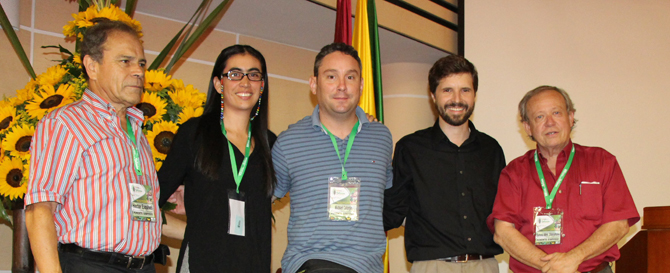
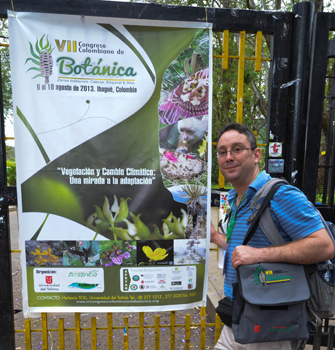 Montgomery’s staff, members, research fellows and colleagues were well represented at the VII Congreso Colombiana de Botánica (Colombian Botanical Congress), held this past week at the Universidad del Tolima in Ibagué, Colombia. The Congress was coordinated by Hector Esquivel, long-time MBC collaborator and Director of the TOLI herbarium and the Alexander von Humboldt Botanical Garden of the Universidad del Tolima.
Montgomery’s staff, members, research fellows and colleagues were well represented at the VII Congreso Colombiana de Botánica (Colombian Botanical Congress), held this past week at the Universidad del Tolima in Ibagué, Colombia. The Congress was coordinated by Hector Esquivel, long-time MBC collaborator and Director of the TOLI herbarium and the Alexander von Humboldt Botanical Garden of the Universidad del Tolima.
Michael Calonje and Dennis Stevenson organized a symposium on Systematics and Conservation of Neotropical Gymnosperms, which featured talks by Michael and Dennis, as well as Hector Esquivel, Cristina Lopez-Gallego, and Chad Husby. The session covered cycads, conifers, and gnetophytes, with an emphasis on the Colombian species. Michael states, “The gymnosperm symposium included talks about the major gymnosperm groups and provided a good balance of topics including conservation, taxonomy, phylogenetics and ecology. I was happy to see that the sessions were very well-attended and the talks generated a lot of interest among the attendees.”
 The theme of the conference was looking at adaptation of vegetation in response to climate change, and included over 200 speakers from many different areas of botanical study.
The theme of the conference was looking at adaptation of vegetation in response to climate change, and included over 200 speakers from many different areas of botanical study.
Michael and Chad were also honored to attend a dinner meeting of the Association of Botanic Garden Directors of Colombia. Chad observes: "It was a great honor to join the Botanical Garden Directors of Colombia and learn of the important and exciting work being done by their gardens. The Directors likewise showed great interest in the work of MBC. We made important connections with colleagues that create opportunities for future collaboration.”
August 8, 2013
Seminar: Patterns in cycad diversity and fern distribution -- Nathalie Nagalingum
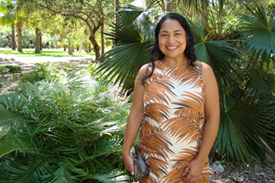 On August 8, 2013, Dr. Nathalie Nagalingum from the Royal Botanic Garden, Sydney, Australia described the historical and modern day patterns that have resulted in the living biological diversity of cycads and ferns.
On August 8, 2013, Dr. Nathalie Nagalingum from the Royal Botanic Garden, Sydney, Australia described the historical and modern day patterns that have resulted in the living biological diversity of cycads and ferns.
Cycads have been long thought of as "living fossils" but molecular clock analysis reveals strikingly young ages. Despite their recent origins, much of cycad diversity is at risk of extinction. Nathalie described future projects planned to address this issue through conservation genetics.
Ferns have a wide range of habitat preferences and are widely distributed, thus they are an ideal group for understanding how diversity is distributed. Using Australia as a study region she has analyzed patterns of fern diversity using standard taxon-based metrics as well as phylogenetic indices. These measures identify hotspots of diversity and can be used for conservation planning.
Nathalie's travels to Montgomery and to other research centers in North America are funded by the Winston Churchill Memorial Trust. Please see Dr. Nagalingum’s website for more information: http://www.evolutionofplants.org.
Dr. Patrick Griffith, MBC Executive Director was happy the lecture was well attended by many local collaborators: "I am glad that Dr. Nagalingum chose to spend a week at Montgomery as part of her travels, studying our collections and meeting with our team and our colleagues. We have a lot of common challenges and interests in cycad conservation and research, and our gardens can work together in these areas. I see great things ahead!"
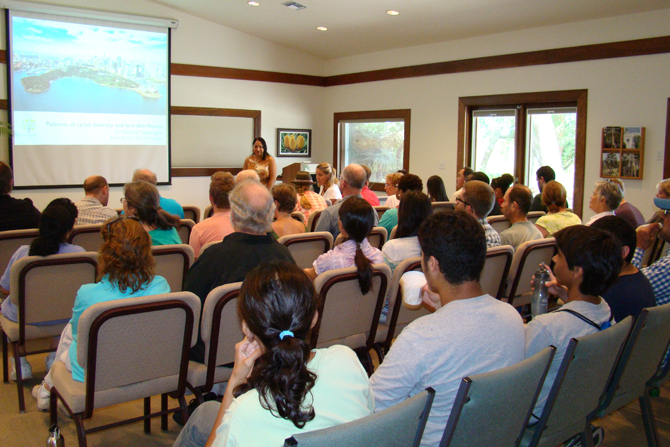
August 2013
Brown Anoles "Spotlighted" at MBC
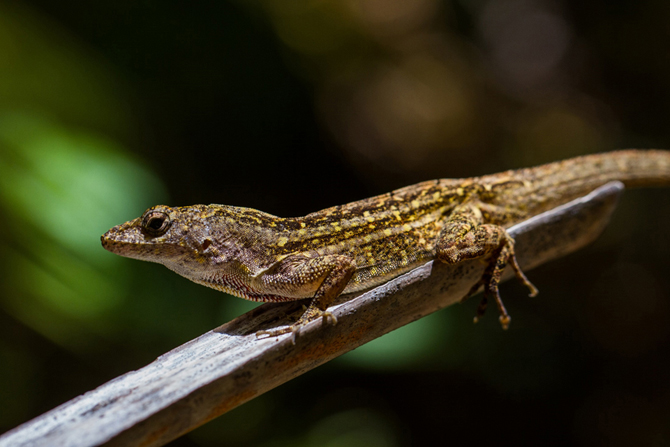
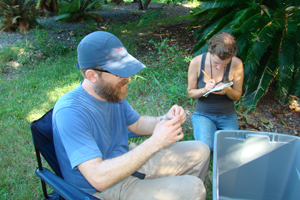 Jason Kolbe, a biologist at the University of Rhode Island (URI), found a new and interesting topic to research at Montgomery Botanical Center. At Montgomery, his research has focused primarily on urbanization and the effect of light on brown anoles. Haley Moniz, Dr. Kolbe's undergraduate student, spent two months at Montgomery to set up an experiment in dark areas with artificial light sources and monitored anole activity daily.
Jason Kolbe, a biologist at the University of Rhode Island (URI), found a new and interesting topic to research at Montgomery Botanical Center. At Montgomery, his research has focused primarily on urbanization and the effect of light on brown anoles. Haley Moniz, Dr. Kolbe's undergraduate student, spent two months at Montgomery to set up an experiment in dark areas with artificial light sources and monitored anole activity daily.
Montgomery was selected as a location that is supportive of research, and also has a thriving brown anole population. The 120 acre garden is a wonderful habitat for many local animals.
"I’m thrilled to see another way Montgomery can advance scientific research," said Executive Director Patrick Griffith. "Most of our visitors are botanists, but our plant collections provide habitat for lots of other interesting life."
July 11, 2013
Montgomery Botanical Center Receives International GIS Award
On July 10, 2013 in San Diego, California, Montgomery Botanical Center (MBC) received a Special Achievement in GIS (SAG) Award at the Esri International User Conference (Esri UC). This international award acknowledges vision, leadership, hard work, and innovative use of Esri's geographic information system (GIS) technology.
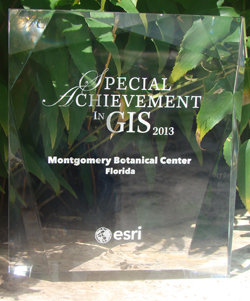 Montgomery Botanical Center uses Esri ArcGIS technology for imagery and spatial analysis to build maps to visualize the specimens and topography of the property, in order to better perform research tasks and care for the 13,000+ plants that comprise our collections. A detailed contour map of the MBC property was created for staff use, road and lake edges were re-aligned, and canopy health improvement was evaluated. By visualizing the tree canopy, to date 32 new state champion and 3 national champion trees have been identified. Following this discovery, an application on champion trees was created with Esri software and is being used as a tutorial on Esri's website.
Montgomery Botanical Center uses Esri ArcGIS technology for imagery and spatial analysis to build maps to visualize the specimens and topography of the property, in order to better perform research tasks and care for the 13,000+ plants that comprise our collections. A detailed contour map of the MBC property was created for staff use, road and lake edges were re-aligned, and canopy health improvement was evaluated. By visualizing the tree canopy, to date 32 new state champion and 3 national champion trees have been identified. Following this discovery, an application on champion trees was created with Esri software and is being used as a tutorial on Esri's website.
Ericka Witcher, MBC Collections Supervisor and GIS Specialist, accepted the award on behalf of Montgomery. Ericka and the rest of the Montgomery Team are leading the world in innovative uses for Esri software. Esri president Jack Dangermond (pictured below with Ericka) stated:
"The SAG Awards identify the organizations and people that are using the power of geography to improve our world and drive change. At Esri, we are always deeply inspired by the passion and innovation of our users. They deserve recognition for both solving their communities’ greatest challenges and for their invaluable contributions to the continued evolution of geographic science.”
For more information about the 2013 Special Achievement in GIS Award winners, including project information and photos, please visit the Esri website.
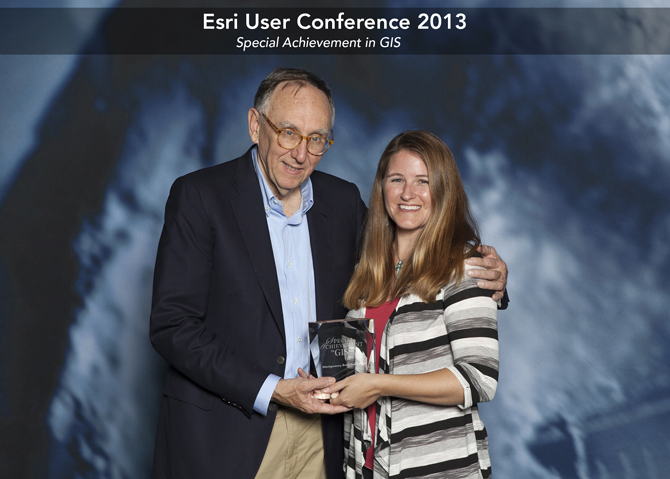
July 1, 2013
Cycad Paleobotanist visits Montgomery to Research for One Year!
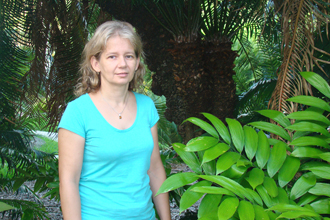 On July 1, Dr. Boglarka Erdei of the Hungarian Natural History Museum began working at Montgomery Botanical Center. Dr. Erdei is scheduled to study Montgomery's cycad collection for one year. Boglarka has published papers on fossil cycads and is now working on a project to compare what she knows about extinct cycads with extant (present day) cycads.
On July 1, Dr. Boglarka Erdei of the Hungarian Natural History Museum began working at Montgomery Botanical Center. Dr. Erdei is scheduled to study Montgomery's cycad collection for one year. Boglarka has published papers on fossil cycads and is now working on a project to compare what she knows about extinct cycads with extant (present day) cycads.
Boglarka works with the museum's Palaeobotanical Collection and is an expert on the Tertiary collections. She is currently researching the extinct Dioonopsis and making comparisions between it and modern Dioon. Boglarka's work is partially supported by The Hungarian American Enterprise Scholarship Fund.
Please join us in welcoming Dr. Boglarka Erdei to the Montgomery team. At the end of her time at Montgomery, she will be giving a presentation about her work. Please check back at about this time next year for more information.
June
31, 2012
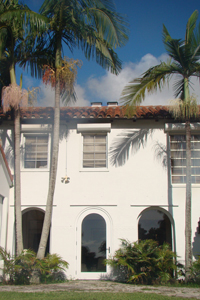 The Villagers Support Nell’s House Arched Door Restoration
The Villagers Support Nell’s House Arched Door Restoration
Last year, The Villagers awarded MBC a grant to support the restoration of the rear arched door at Nell’s House. The door frames the view down the allée to Royal Lake.
Constructed in 1932, the original door warped and was no longer keeping out the elements. The new door is impact resistant, energy efficient, and was built to look just like the original door. It keeps with the original Mediterranean revival architecture of Nell's House and it continues to frame the iconic view.
The Villagers are dedicated to
the restoration and preservation of historic sites. They have supported
numerous projects here at Montgomery Botanical Center and around the county. The Villagers host a home tour and a garden tour each year to raise funds for local preservation projects.
Montgomery Botanical Center is ever thankful to the Villagers for their continued support and generosity. The door is restored and is looking beautiful and functioning properly again.
June 21, 2013
New Study by Montgomery: Morphology of Syagrus, Attalea, and Related Palms.
Larry Noblick and colleagues have just published an extensive study of New World palms.The work carefully examines the morphology and anatomy of the close relatives of the Coconut Palm – Syagrus, Attalea, Butia and others – and considers how these are all related based on this information.
Larry’s study of these palms began in the 1980s for his graduate study. His extensive fieldwork throughout South America and the Caribbean over the decades has developed both a leading living collection of these palms at Montgomery, as well as extensive herbarium specimens documenting these plants. In total, specimens from 47 different herbaria were carefully studied. These living and preserved collections provide a rich source of information – the very structure of the plants – which can be used to consider how these palms have evolved.
These palms include amazing diversity of habit and shape, with some of the most massive palms known, and also some of the smallest. The work found that perhaps the genus Syagrus is not held together by a single common ancestor, as several other recognized genera appear to group within Syagrus. Further research involving other kinds of data will help resolve these questions.
The study appears in the journal Brittonia, Volume 65, which is published by The New York Botanical Garden.
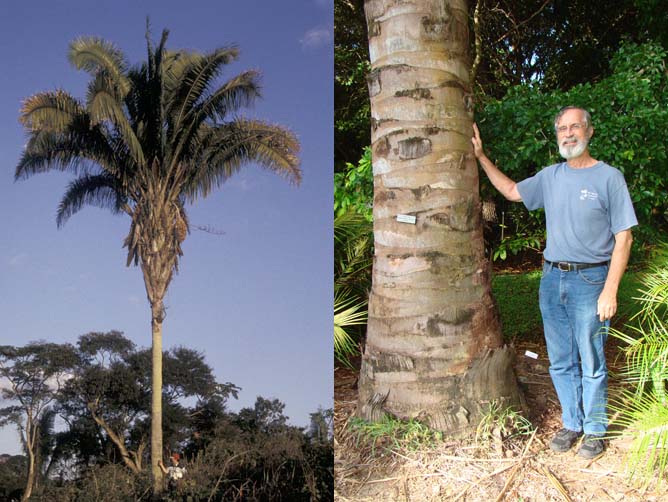
June 20, 2013
The World List of Cycads: a New Online Resource
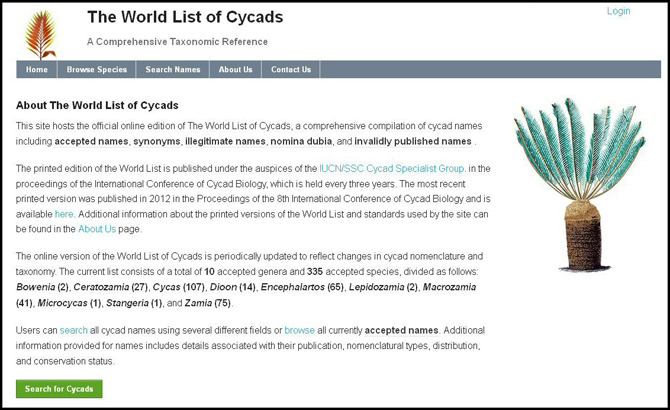
Montgomery is excited to announce a new online resource for cycads — www.cycadlist.org — the official World List of Cycads Website.
Cycad biology is a very active field — with new discoveries from ongoing fieldwork, increasing data about cycad diversity, and vigorous efforts to conserve these amazing plants, the need for an up-to-date list of accepted cycad species is greater than ever.
The World List of Cycads is regularly published in the Proceedings of the International Cycad Conferences. These World List papers summarize accepted species names along with synonyms, dubious names and illegitimate names in a single place — this facilitates greater coordination among the world’s cycad researchers by providing a common taxonomic framework.
Most importantly, vital conservation efforts rely on good taxonomy. The IUCN (World Conservation Union) uses the World List of Cycads to inform the IUCN Red List of Threatened Species, which is used by governments, land managers and biologists worldwide.
Seeing this clear need for reliable taxonomy, in 2011 the Cycad Specialist Group of the IUCN Species Survival Commission agreed that a frequently updated and searchable online version of the World List would be a valuable resource for cycad researchers and conservationists alike. The new website allows for immediate updates to reflect changes in cycad nomenclature and taxonomy, provides advanced search capabilities within a user-friendly interface, and supplies extensive links to primary source information.
The online World List of Cycads is designed and managed by Michael Calonje, with nomenclature editors Leonie Stanberg and Dennis Stevenson.

May 20-24, 2013
Montgomery at APGA 2013 — National Botanic Garden Conference
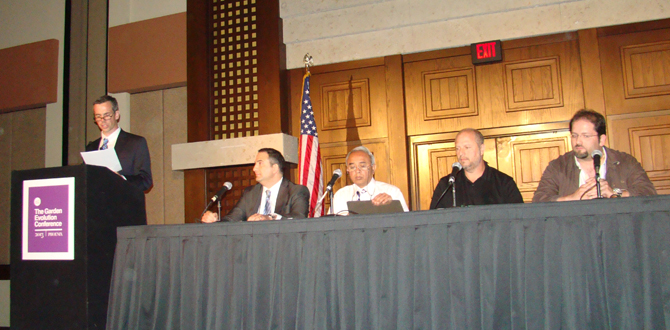
This year, 750 national and international garden professionals attended the American Public Gardens Association national conference held in Phoenix, Arizona.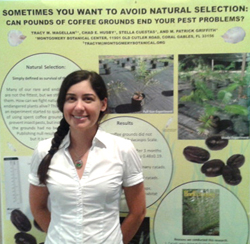 This conference gave attendees the opportunity to network and develop garden collaborations and also to learn from colleagues in the field through a series of sessions.
This conference gave attendees the opportunity to network and develop garden collaborations and also to learn from colleagues in the field through a series of sessions.
Montgomery Outreach Manager Tracy Magellan presented a poster titled, “Sometimes you want to avoid natural selection: Can pounds of coffee grounds end your pest problems?” on the effectiveness of using spent coffee grounds to control Cycad Aulacaspis Scale.
Executive Director M. Patrick Griffith of Montgomery Botanical Center gave a presentation titled,“Underground Plants Help Conservation on the Surface” where he discussed fieldwork and research in Belize funded by the Institute of Museum and Library Services (IMLS), the International Union for Conservation of Nature—Save Our Species Grant (IUCN—SOS), and the Mohamed bin Zayed Species Conservation Fund. 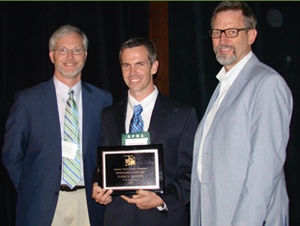 Dr. Griffith also moderated a panel discussion on “Plant Conservation in Arid Lands: International Collaborations.”
Dr. Griffith also moderated a panel discussion on “Plant Conservation in Arid Lands: International Collaborations.”
Patrick was awarded the APGA's Professional Citation Award, a prestigious award given once a year. Since joining MBC in 2005, Patrick has encouraged and developed the research, conservation, and authorship work of our team, helping Montgomery to make a unique contribution to this field. The staff at Montgomery Botanical Center would like you to join us in celebrating Dr. Patrick Griffith for all the good work he has done.
Montgomery Botanical Center is a member of the American Public Gardens Association (APGA) and holds the APGA North American Plant Collections Consortium (NAPCC) national collections of palms and cycads. MBC staff travel to the conference was supported by a Museums for America Grant from IMLS and by a generous donation from Charles and Dorothy Sacher.
May 21, 2013
Lecture by Cycad Expert: Conservation Plan for Zamia in Colombia
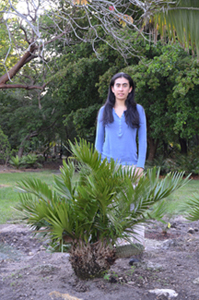 Montgomery hosted a lecture by cycad conservation expert, Dr. Cristina Lopez-Gallego, who is Professor at Universidad de Antioquia, Medellín, Colombia, and Research Fellow at MBC.
Montgomery hosted a lecture by cycad conservation expert, Dr. Cristina Lopez-Gallego, who is Professor at Universidad de Antioquia, Medellín, Colombia, and Research Fellow at MBC.
With 20 species, Colombia has the richest Zamia flora in the world. These Zamia live in a wide range of habitats, from the wettest forests on earth to arid deserts. Colombia has the cycad with the largest leaflets (Zamia wallisii), and the only Zamia with a prominent midvein in its leaflets (Zamia restrepoi). Many of Colombia's Zamia are of serious conservation concern, with at least half Critically Endangered or Endangered. Conservation of these remarkable plants is extremely important, so Dr. Lopez-Gallego has worked to develop strategies for ensuring their survival.
Dr. Cristina Lopez-Gallego received her Ph.D. in Conservation Biology from the University of New Orleans in 2007 with a dissertation entitled "Effects of habitat degradation on the evolutionary dynamics of populations in a rainforest cycad." Her research is focused on cycad conservation and ecology in Colombia. She has been on the faculty of the Universidad de Antioquia in Colombia since 2007. She is also a longtime collaborator and Research Fellow with MBC. Her studies at Montgomery are generously supported by the Kelly Botanical Research Fellows Program.
May 9, 2013
Zamia Update: an Old Cycad Mystery and a New Discovery
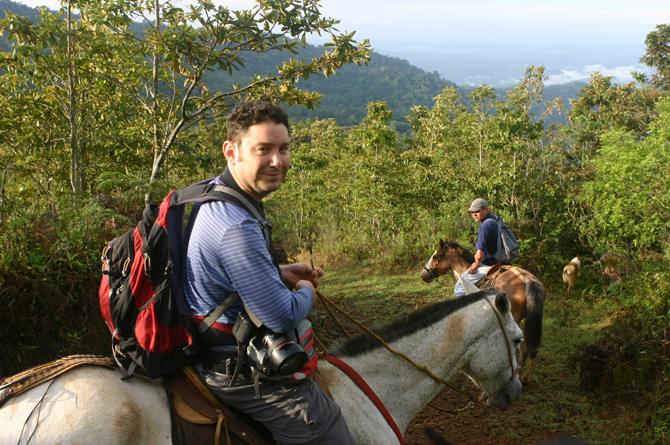
Biologists from Montgomery recently worked with an international team to clarify the taxonomy of Central American cycads. The new study brings to light a complicated botanical history. Around 1846, Anders Sandøe Ørsted collected a single leaf specimen with very little information, simply noting it as from “the San Juan River, Nicaragua.” That single specimen was the basis for Zamia acuminata, described by William Thiselton-Dyer in 1884. Exploration over the next 160 years found no additional specimens in Nicaragua or adjacent Costa Rica, making this a very mysterious plant!
Recent fieldwork led by Michael Calonje, along with careful review of specimens and literature convinced Michael to explore the idea that perhaps Ørsted's specimen may have been collected in Costa Rica in route to the San Juan River, and not at the San Juan River itself. One source of the confusion is the ambiguity in Ørsted’s brief specimen annotation in Latin, which could be interpreted as meaning either “at” the river or “to” the river.
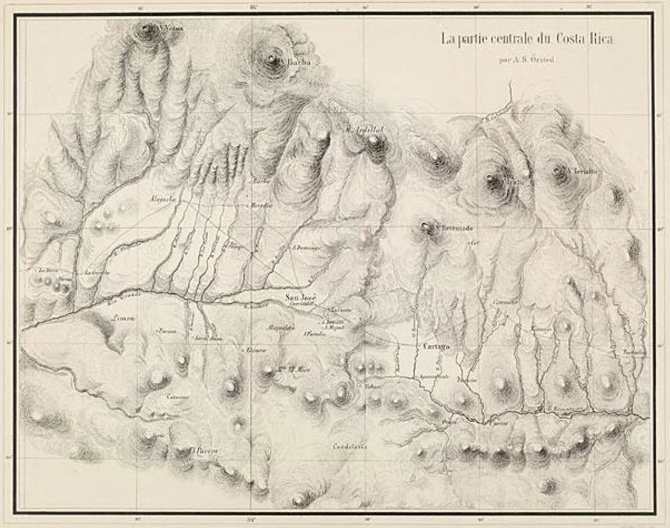 By painstakingly reconstructing, mapping and traveling Ørsted’s 1846 route, from his 1863 travelogue, and studying new specimens collected in Costa Rica, Michael and his colleagues determined that Ørsted’s specimen exactly matched recent collections from the western Sierra de Talamanca, nearly 100 km south of the Rio San Juan, but within close range to Ørsted’s route to the San Juan River in Nicaragua.
By painstakingly reconstructing, mapping and traveling Ørsted’s 1846 route, from his 1863 travelogue, and studying new specimens collected in Costa Rica, Michael and his colleagues determined that Ørsted’s specimen exactly matched recent collections from the western Sierra de Talamanca, nearly 100 km south of the Rio San Juan, but within close range to Ørsted’s route to the San Juan River in Nicaragua.
This new work also identifies and describes a new species from Panama, Zamia nana. For many years, Zamia nana was confused with Zamia acuminata due to its similar leaflet shape. However, the new species is a much smaller plant than Zamia acuminata and is restricted to a small crater of an extinct Volcano in Coclé Province, Panama.
Michael states: “Zamia nana has been well-known in cultivation and botanical garden collections for decades under the misapplied name Zamia acuminata, whereas the true Zamia acuminata from Costa Rica has remained poorly known prior to this multi-institutional collaborative study. This case illustrates the importance of making complete herbarium specimen collections with detailed location and descriptive information to avoid future taxonomic ambiguity."
The study, authored by Anders Lindstrom, Michael Calonje, Dennis Stevenson, Chad Husby, and Alberto Taylor can be seen in the latest issue of Phytotaxa, volume 98, issue 2.
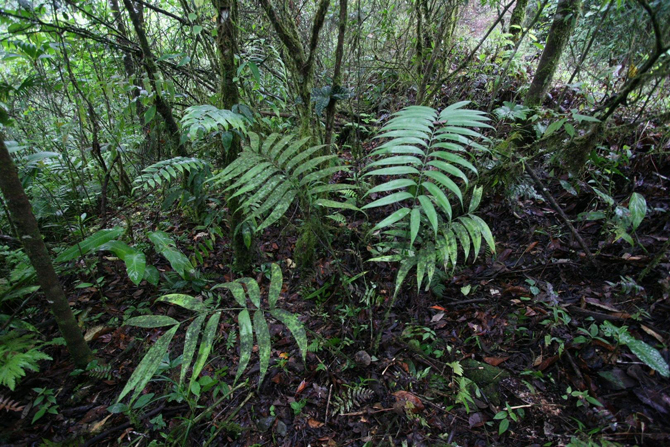
May 9, 2013
Palm Conservation Meeting in the Dominican Republic
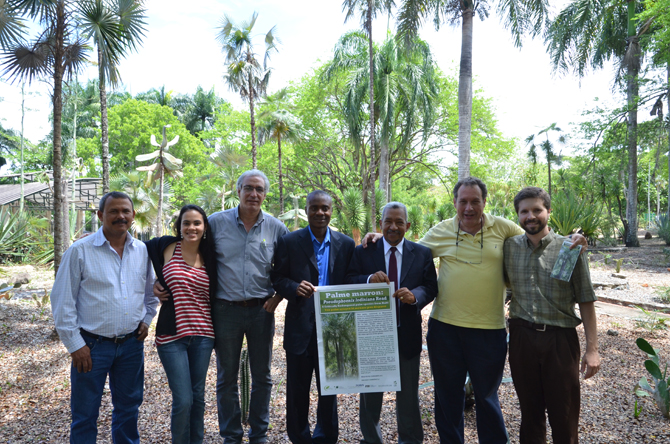
On May 9, a symposium entitled "Palms of Hispaniola" was held at the Jardín Botánico Nacional Dr. Rafael Ma. Moscoso (JBSD) in Santo Domingo, Dominican Republic. This symposium was part of a project, sponsored by a grant from the Mohamed bin Zayed Species Conservation Fund, to study and conserve the critically endangered Haitian endemic palm Pseudophoenix lediniana. Montgomery is one of the collaborating gardens in this project.
During the symposium, Chad Husby presented a talk entitled, "The conservation and research program at Montgomery Botanical Center," focusing on MBC's palm work. Other key participants in the program included Dr. Javier Francisco-Ortega (Fairchild and FIU), Ricardo Garcia (director of JBSD), William Cinea (director of the Cayes Botanical Garden, Haiti), Alberto Veloz (JBSD), Rosa Rodriguez (FIU graduate student working with Pseudophoenix), and Francisco Jiménez (JBSD).
The program was well received by the attendees who asked many questions during the final roundtable discussion.
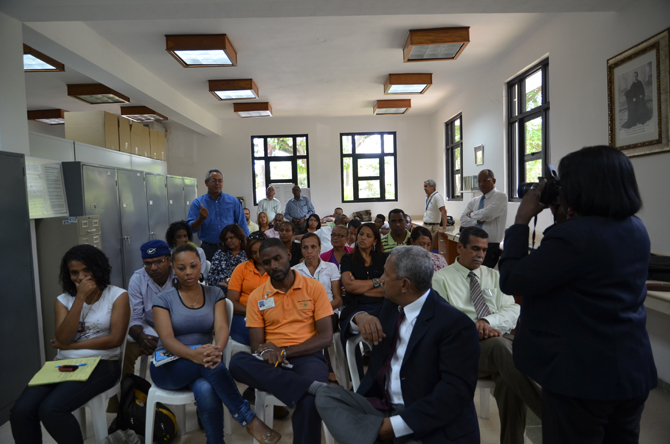
May 4, 2013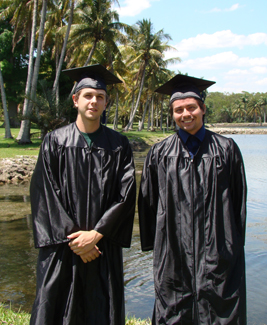
Congratulations to Xavier and Michael
Please join us in congratulating Xavier Gratacos and Michael Tsairis on their graduation from Miami Dade College. Michael Tsairis is currently our Conservation Horticulture Fellow and Xavier Gratacos was a former Conservation Horticulture Fellow, and is now Assistant Curator at Montgomery Botanical Center.
Mr. Tsairis now holds an Associate in Arts in Landscape Architecture with a Horticulture Specialist Certificate. He is now pursuing a B.S. in Botany and Business. Mr. Gratacos received his Associate in Science in Landscape and Horticulture Technology. Congratulations to our newest colleagues in the field of horticulture!
April 22, 2013
Montgomery Research Featured on the Cover of HortTechnology:
Coffee Does Not Control Cycad Aulacaspis Scale
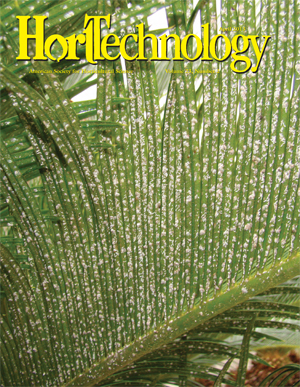 The April 2013 issue of HortTechnology features new research by Tracy Magellan, Chad Husby, Stella Cuestas, and M. Patrick Griffith which found that spent coffee grounds do not control Cycad Aulacaspis Scale (Asian Cycad Scale, CAS).
The April 2013 issue of HortTechnology features new research by Tracy Magellan, Chad Husby, Stella Cuestas, and M. Patrick Griffith which found that spent coffee grounds do not control Cycad Aulacaspis Scale (Asian Cycad Scale, CAS).
This scale insect, Aulacaspis yasumatsui, is a very destructive pest of cycads. CAS has not only been responsible for killing many of the ornamental Cycas plantings in South Florida, but also threatens Guam’s native cycad species with extinction. Controlling CAS is therefore a high priority for conservation horticulture.
Recent years saw growing enthusiasm for controlling CAS with spent coffee grounds, shown by online discussions and popular articles. The Montgomery Team made initial trials using donated coffee grounds, but soon realized that a formalized experiment – using isolated variables, controls, measurements and statistics – would allow insight into how effective the treatment actually performed.
Two sets of rigorous experiments were conducted to evaluate how coffee treatments affect scale infestations. The results show that coffee grounds have no significant effect on CAS. While used grounds may function as a soil conditioner or mulch, they are not effective as a scale control method. Quoting from the paper: 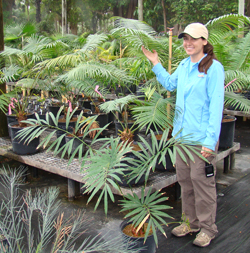
“Despite recent enthusiasm for this recycled resource, spent coffee grounds do not appear to protect cycads from CAS.”
Tracy elaborates,
“I began this study to quantify how effectively coffee grounds cleared cycads of CAS. As disappointed as I was to find out that the coffee treatments did not work, it was important to get the information to the public. We learned a few things in this paper: coffee grounds do not affect cycad mortality, so mulching plants with your grounds will not do your plants harm and it still keeps coffee grounds out of landfills; orange and neem oil do cause plant mortality and therefore should not be used on cycads; and coffee grounds did significantly acidify the pH of the soil by the end of the experiment.”
Montgomery thanks John DeMott of Redland Nursery for providing experimental plants and Starbucks Coffee for providing a great volume of spent coffee grounds over the course of the study.
April 17, 2013
New Paper: Cycad Conservation in The Bahamas:
Genetics, ex situ collections, and demographic assessment.
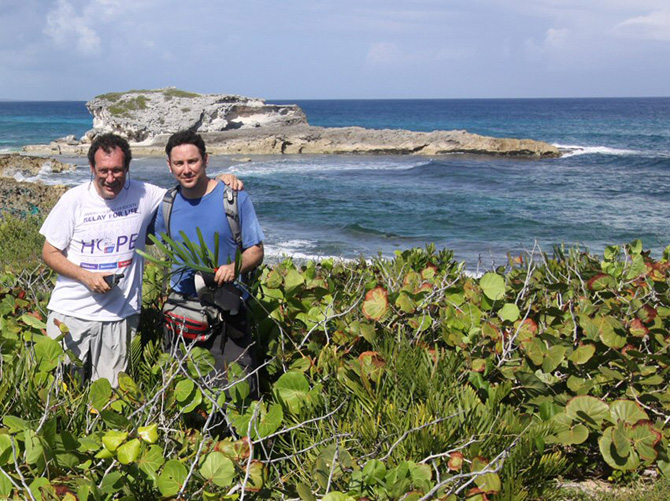
Michael Calonje, Montgomery cycad biologist, and his colleagues — David Knowles and Lindy Knowles from the Bahamas National Trust, Javier Francisco-Ortega at FIU and FTBG, Alan Meerow and Kyoko Nakamura from the USDA, and Patrick Griffith — just published a landmark paper on the conservation biology and population genetics of Zamia in The Bahamas.
The paper focused on Zamia lucayana, which is only known from a narrow area of coastal habitat on Long Island, but also surveyed the two other Bahamian species, Z. integrifolia and Z. angustifolia. Zamia integrifolia occurs on several Bahamian islands. Perhaps the most urgent survey finding was that Bahamian Z. angustifolia is reduced to just 150 adult plants on Eleuthera.
Conservation survey found less than 1,000 adult Z. lucayana plants, which are threatened by development. Germplasm for ex situ conservation was distributed to the Bahamas National Trust and leading cycad collections in the US, China, and Mexico.
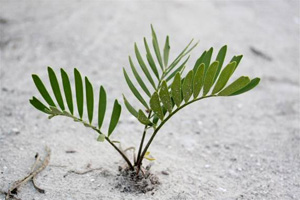 The population genetics of Z. lucayana were investigated in detail through DNA microsatellite markers. Results indicate that the separate populations of Z. lucayana were historically connected through interbreeding, but are experiencing genetic drift due to recent isolation. Michael states:
The population genetics of Z. lucayana were investigated in detail through DNA microsatellite markers. Results indicate that the separate populations of Z. lucayana were historically connected through interbreeding, but are experiencing genetic drift due to recent isolation. Michael states:
"We found the three main Zamia lucayana populations had enough genetic similarity to each other to be considered a single population for conservation purposes. The populations were healthy and reproductively active, but several real estate subdivisions surrounded the habitat. We hope that future residential development within the vicinity will take place without directly impacting the small coastal dune population of these endangered plants."
The paper represents the first in-depth study of conservation genetics of a Critically Endangered endemic plant in the Bahamas archipelago and of the few studies focusing on plants from the Caribbean Islands Biodiversity Hotspot. Javier, the study’s leader, states:
"This study demonstrates the synergy that can develop for Caribbean plant conservation when you have a team with extraordinary molecular and field skills. I am not aware of any other published study for Caribbean endemic plants that has such a complete output pertinent to basic population genetic questions, conservation management recommendations, and exhaustive field work."
The paper appears in the latest issue of Oryx, the International Journal of Conservation, the leading journal for applied conservation worldwide. This work was generously supported by a grant from the Mohamed bin Zayed Species Conservation Fund, an award from the National Science Foundation, a Christiane Tyson Research Fellowship, and funds from the participating organizations.
March 16, 2013
Loyd G. Kelly Conservation Nursery Dedication
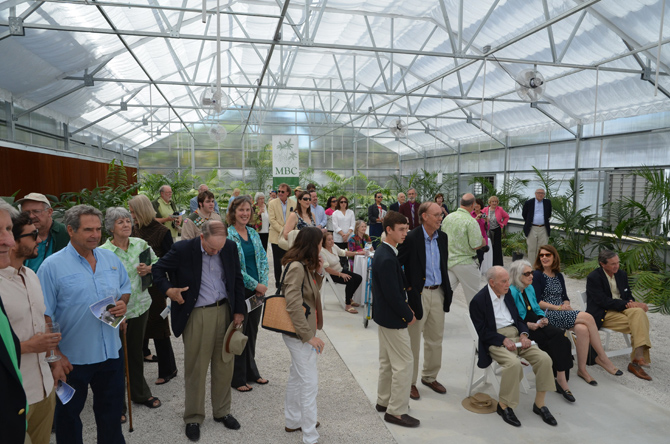
On March 16, 2013, Montgomery Botanical Center dedicated its newly upgraded nursery complex for Loyd Kelly, long time Member and Board Member.
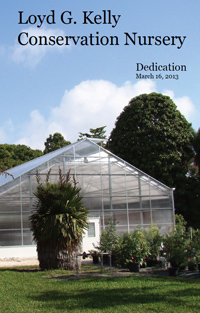 On behalf of Montgomery, Patrick Griffith, MBC Executive Director, welcomed the large group of supporters, friends and family, who turned out to honor Loyd for his decades of service, support and commitment. The new and upgraded plant propagation complex is vital to Montgomery. Each plant here begins its life in the nursery. The upgrade to the 1932 facilities will better meet plant requirements and provide more space. The project was carefully planned, designed, sited and built to allow more numerous and diverse palms, cycads and conifers. This fundamental work – growing seedlings – is the first step in conserving imperiled plants.
On behalf of Montgomery, Patrick Griffith, MBC Executive Director, welcomed the large group of supporters, friends and family, who turned out to honor Loyd for his decades of service, support and commitment. The new and upgraded plant propagation complex is vital to Montgomery. Each plant here begins its life in the nursery. The upgrade to the 1932 facilities will better meet plant requirements and provide more space. The project was carefully planned, designed, sited and built to allow more numerous and diverse palms, cycads and conifers. This fundamental work – growing seedlings – is the first step in conserving imperiled plants.
Chad Husby, MBC Collections Manager, spoke to highlight how the new facility enables MBC to do so much more. Modern advances in greenhouse design and plant propagation technology will give the young plants the best care available.
Walter Haynes, MBC Treasurer, spoke about the great legacy Loyd created for Montgomery. Loyd’s tenure as President (1990-1996) following Nell Montgomery’s death laid the foundation for our current successes. Loyd’s talent for leadership and organization renewed the team and set clear vision and direction. Loyd organized the restoration of facilities and collections following Hurricane Andrew, and hired MBC’s first Executive Director and Biologists. After 20 years of service the Board reluctantly accepted his retirement, and elected Loyd as Director Emeritus. Walter spoke:
“Do we miss you Loyd? Well––Yes and no. Yes, we miss you––because every day we miss your wise counsel. No, we do not miss you––because every day as we look around, we see what you made possible to achieve here. We will never forget what you have done here.”
Patrick then recognized the supporters of the Loyd G. Kelly Conservation Nursery – Kelly Foundation, The Batchelor Foundation, National Science Foundation, Stanley Smith Horticultural Trust, Helen C. Frick Foundation, and Boy Scout Troop 457 – their generous support made this project possible!
Nick Kelly, MBC President, also thanked everyone for their generosity, support and colleagueship. To demonstrate the importance of the new facility, Nick held up several small seeds, and had the audience compare them to the large palms nearby.
“Everyone can appreciate the beauty of a giant palm, but getting from a seed to a big tree takes a lot of effort and care. And that’s what this facility is all about.”
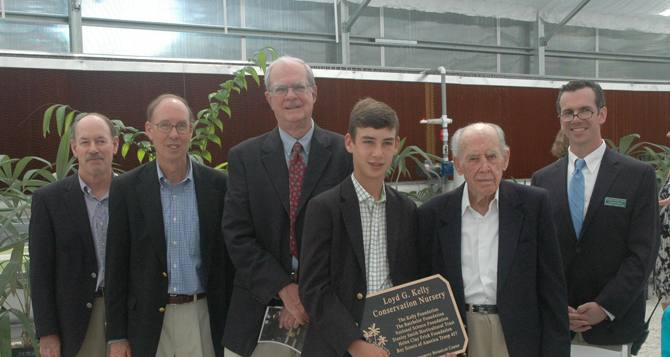
March 13, 2013
Montgomery Botanical Center Commended by Miami School Board
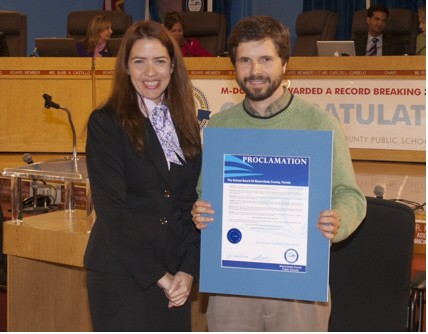 Montgomery was recently recognized by the School Board of Miami-Dade County. A proclamation sponsored by Ms. Raquel Regalado, the School Board Member whose district includes MBC, listed the numerous ways MBC helps advance education, and commends Montgomery for its “dedication to preserving the environment, as well as for advancing research, conservation and education through scientific plant collections.” The proclamation was unanimously put forward by the School Board on March 13, 2013.
Montgomery was recently recognized by the School Board of Miami-Dade County. A proclamation sponsored by Ms. Raquel Regalado, the School Board Member whose district includes MBC, listed the numerous ways MBC helps advance education, and commends Montgomery for its “dedication to preserving the environment, as well as for advancing research, conservation and education through scientific plant collections.” The proclamation was unanimously put forward by the School Board on March 13, 2013.
Dr. Chad Husby, Collections Manager, gratefully accepted the proclamation on behalf of Montgomery. Chad was given the opportunity to address the School Board and the public attendees, speaking about the ways MBC plants have been used in education, and how that serves the MBC mission. Chad stated, “Montgomery Botanical Center has a long history of introducing students in Miami-Dade County to the wonders of the plant world and engaging them in the exciting work of a botanic garden focused on science and conservation."
Montgomery Botanical Center continues to find many ways that research plants can help advance education. For more information, see the education webpage.
March 2013
Spring/Summer 2013 Montgomery Botanical News is Now Online!
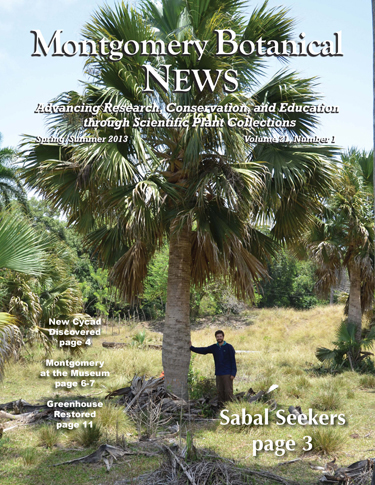 This new issue has articles about a palms in the Dominican Republic and Texas, and cycads in Colombia. It also highlights the Plant Exploration exhibit at the Coral Gables Museum, which introduced Montgomery Botanical Center to many members of our local community.
This new issue has articles about a palms in the Dominican Republic and Texas, and cycads in Colombia. It also highlights the Plant Exploration exhibit at the Coral Gables Museum, which introduced Montgomery Botanical Center to many members of our local community.
Please see page 11 and the back cover for information on our newly restored original 1932 greenhouse. Make sure not to miss the article, "An Anatomist's Garden," which is about all the great new work is being done by visiting scientists this year.
Montgomery Botanical Center publishes two newsletters a year to keep our supporters and collaborators up to date and informed.
To read more about how Montgomery Botanical Center meets our mission of "Advancing Research, Conservation, and Education through Scientific Plant Collections" please see our newsletters online.
March 9 - March 10, 2013
South Florida Palm Society 2013 Spring Palm Show & Sale
Montgomery in March
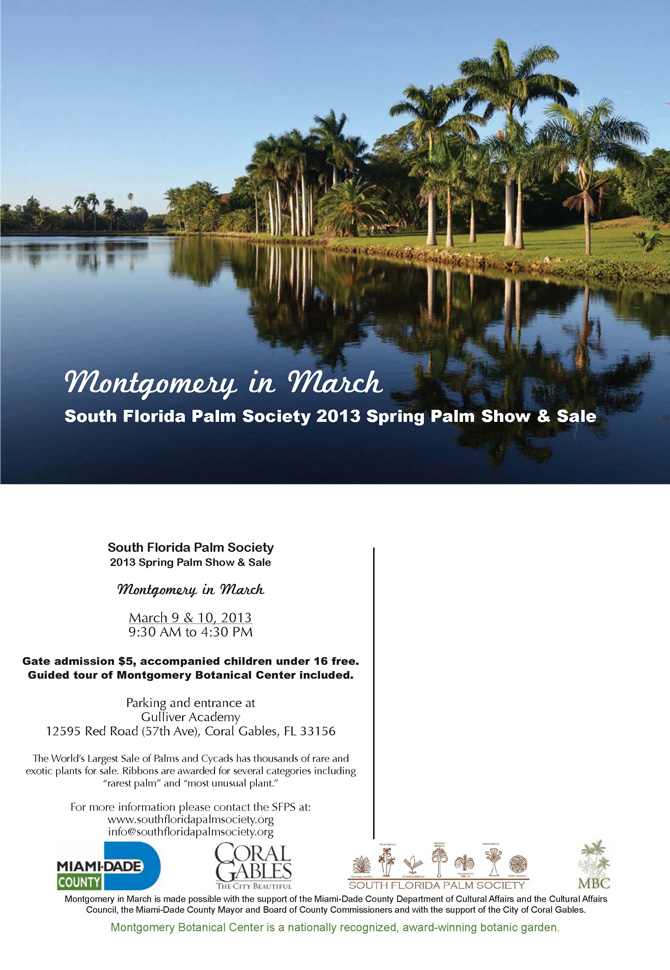
January 26, 2013
NSF Cycad Biology Teachers Workshop
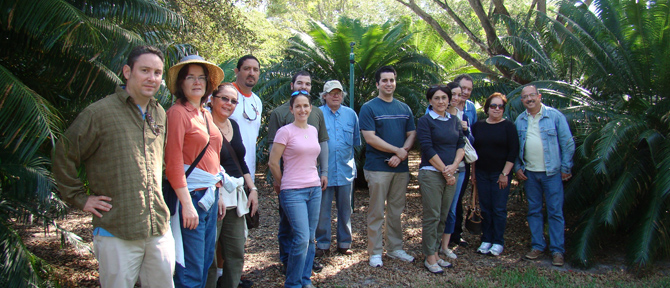
On January 26th, New York Botanical Garden, Florida International University, Fairchild Tropical Botanic Garden, and Montgomery Botanical Center offered a Cycad Biology Course to teachers from Miami-Dade County Public Schools. The course was sponsored by the National Science Foundation and taught by Dennis Stevenson (NYBG), Michael Calonje (MBC), Javier Francisco-Ortega (FIU-Fairchild), and Patrick Griffith (MBC). 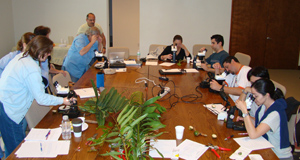
Nine school teachers and Nicolas Espinosa, National Science Foundation Intern from FIU, attended the course. NYBG, FIU, FTBG, and MBC have been working together to research the genetics of Zamia in the Caribbean. Educational outreach is an important component of this project and the organizations involved are working to make the new information from this project available to the community.
The workshop included classroom lectures and laboratory demonstrations in the Nixon Smiley Meeting Room along with using the living collections of MBC.
Griffith was thrilled with the workshop: “This is an awesome group of teachers — I only wish I could have learned about cycads when I was in grade school! Linking our current science with local educators is a great way to reach the next generation of botanists.”
January 17-18, 2013
APGA Board Visits Montgomery
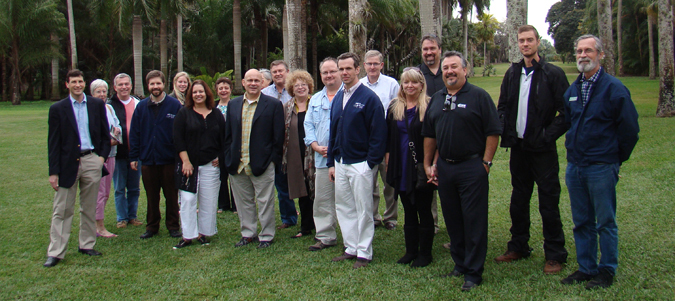
The Board of Directors of the American Public Garden Association (APGA) visited Montgomery Botanical Center for a dinner and tour on January 17th and 18th.
They held their Board meeting in Miami and used the opportunity to visit the
southern Florida member gardens. Montgomery Botanical Center is a member of
the American Public Garden Association and holds the association’s national
palm and cycad collections.
January 14, 2013
The Network for Neotropical Biogeography Meets at Montgomery
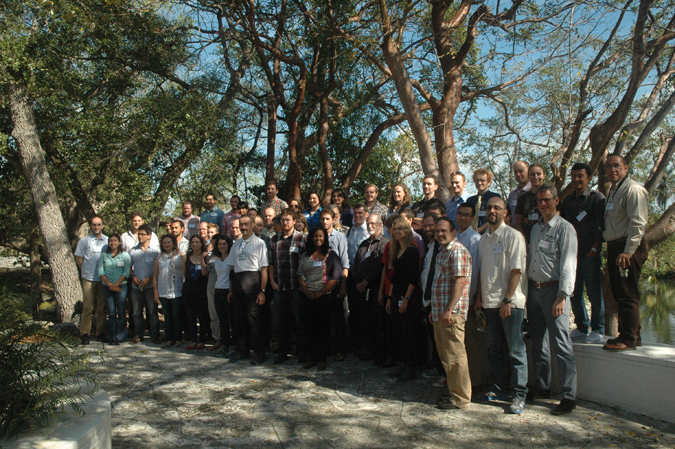
Montgomery hosted the 2nd meeting of the Network for Neotropical
Biogeography (NNTBG) in January. The meeting brought together over 60
experts from around the world who work with tropical plants and other
organisms in the New World.
The NNTBG works to promote coordination and interaction among scientists
working in the tropics. Bring together representatives from as many
research
groups as possible working on neotropical
biogeography and evolution
regardless of methodology, data source, spatial/temporal scale, or
organismal group studied. Talks came from a variety of fields such as
molecular phylogenetics, paleontology and ecology.
January 4 - February 24, 2013
Montgomery Botanical Center Plant Exploration Exhibit at the Coral Gables Museum
Montgomery Botanical Center has grown with Coral Gables, from a unique, out-of-the-way plant collection in 1932, to a thriving center for botany and horticulture, 80 years later. Coral Gables Museum will share the story of plant exploration by this nationally recognized living treasure. This exhibit is generously sponsored by J.P. Morgan Chase & Co.
